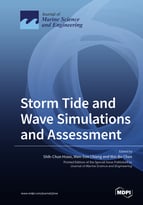Storm Tide and Wave Simulations and Assessment
A special issue of Journal of Marine Science and Engineering (ISSN 2077-1312). This special issue belongs to the section "Ocean Engineering".
Deadline for manuscript submissions: closed (1 December 2020) | Viewed by 24525
Special Issue Editors
Interests: coastal engineering; wave mechanics; numerical analysis; flow in porous media
Special Issues, Collections and Topics in MDPI journals
Interests: wave mechanics; coastal hydrodynamics; sediment transport
Special Issues, Collections and Topics in MDPI journals
Interests: hydrodynamic and hydraulic modeling; storm tide and storm wave modeling
Special Issues, Collections and Topics in MDPI journals
Special Issue Information
Dear Colleagues,
Storm tides, surges, and waves associated with typhoons/tropical cyclones/hurricanes are among the most severe threats to coastal zones, nearshore waters, and navigational safety. Therefore, predicting typhoon/tropical cyclone/hurricane-induced storm tides, surges, and wavesand coastal erosion is important to reduce loss of human life and property and mitigate coastal disasters. Although many studies on hindcasting/predicting/forecasting of typhoon-driven storm tides, surges, waves, and also morphology evolution have been carried out through numerical models in the last decade, there is still a growing demand for novel techniques which could be adopted to resolve the complex physical processes of storm tides, surges, waves, and coastal erosion.
In order to improve our simulating and analytic capabilities and understanding of storm tides, surges, and waves, this Special Issue is intended to collect the latest studies on storm tides, surges, and waves modeling and analysis utilizing dynamic and statistical models and artificial intelligence approaches. Research focusing on model development or model application is welcome. We look forward to receiving contributions in the form of research articles and reviews for this Special Issue. Topics include but are not limited to the following:
- Numerical modeling for storm surge, tide, and wave hindcast/prediction/forecast;
- Statistical analysis for storm surge, tide, and wave hindcast/prediction/forecast;
- Artificial intelligence techniques for storm surge, tide, and wave prediction/forecast;
- Assessment of coastal and marine hazard due to storm surges, tides, and waves;
- Influence of nonlinear interactions on storm tide and wave simulation;
- Effect of meteorological conditions on storm tide and wave simulation;
- High-resolution modeling;
- Coastal morhpology evolution.
Prof. Dr. Shih-Chun Hsiao
Dr. Wen-Son Chiang
Dr. Wei-Bo Chen
Guest Editors
Manuscript Submission Information
Manuscripts should be submitted online at www.mdpi.com by registering and logging in to this website. Once you are registered, click here to go to the submission form. Manuscripts can be submitted until the deadline. All submissions that pass pre-check are peer-reviewed. Accepted papers will be published continuously in the journal (as soon as accepted) and will be listed together on the special issue website. Research articles, review articles as well as short communications are invited. For planned papers, a title and short abstract (about 100 words) can be sent to the Editorial Office for announcement on this website.
Submitted manuscripts should not have been published previously, nor be under consideration for publication elsewhere (except conference proceedings papers). All manuscripts are thoroughly refereed through a single-blind peer-review process. A guide for authors and other relevant information for submission of manuscripts is available on the Instructions for Authors page. Journal of Marine Science and Engineering is an international peer-reviewed open access monthly journal published by MDPI.
Please visit the Instructions for Authors page before submitting a manuscript. The Article Processing Charge (APC) for publication in this open access journal is 2600 CHF (Swiss Francs). Submitted papers should be well formatted and use good English. Authors may use MDPI's English editing service prior to publication or during author revisions.
Keywords
- Numerical modeling
- Statistical analysis
- Artificial intelligence techniques
- Storm tide
- Storm surge
- Storm wave
- Coastal morphology








